|
 Secure Site
Secure Site
|
 |
Archive for the 'Well-being' Category
 well-being practice, walking in nature to relieve stress It’s hard to feel tired or anxious while hiking in the wilderness or staring out at a blue expanse of ocean. “Nature has built-in mechanisms for relieving stress,” says Doreen Sweeting, M.D., founder of Psychosomatic Wellness Intuitive Life Coaching. “There’s aromatherapy in the scent of the pine trees and grass, chromatherapy in the colors of the rocks and sky and flowers, sound therapy in the birdsong and wind rustling the leaves.”
Our society, unfortunately, is increasingly cut off from this wellspring of energy. “We live in artificial light. We walk on concrete. We exercise on machines,” Sweeting says. “We go from home to work to the store and back home.”
Exhaustion Cure: Take a Morning Walk
Whether you live in a suburb or a bustling city, take a walk first thing in the morning — if possible, in an area filled with trees. “You’ll feel the energy of nature replenishing you,” says Sweeting. “The tree huggers are on to something.” As often as possible, venture deeper into the woods by planning day hikes or overnight camping trips.
Make an extra effort to notice the changing seasons. “You’ll start to realize the rhythms of nature apply to you, too,” Sweeting concludes. “When you harmonize yourself with nature, you’ll develop a stronger sense of well-being. The body responds quickly to being honored in this way. And it can all start with getting out to the park.”
adapted from Body + Soul Magazine, March 2009
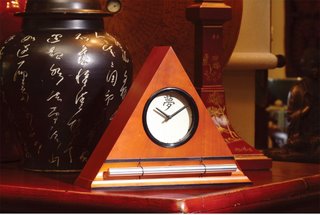 wake up alarm clock with chime, a tool for relieving stress Now & Zen
1638 Pearl Street
Boulder, CO 80302
(800) 779-6383
Posted in mindfulness practice, Well-being
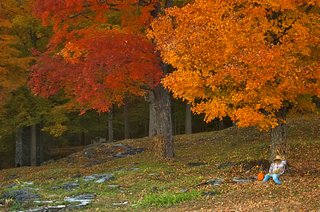 autumn, a time for wellness In Chinese medicine, fall represents a return to the roots, a time of restoring and building our qi for the following spring. “This isn’t a time of growth, but of consolidation,” says Maoshing Ni, Ph.D., director of the longevity program at Tao of Wellness Center in Santa Monica, California. “It’s when we replenish ourselves for the following spring.” Whereas summer’s expansive energy calls us out — to backyard gatherings, family vacations, block parties — autumn speaks to the introvert in each of us, inviting us to get back in touch with our nesting instincts.
Here, we offer an action plan to clean, green, and beautify the space in which you’ll be spending a lot more time once the weather turns cold. Time to make your home as warm, welcoming, and healthy as possible — while nourishing your spirit in the process. Rather than stumble into fall, why not mindfully prepare for it? Once you reorganize and revitalize your surroundings, you’ll be ready for everything the season has to offer.
adapted from WholeLiving.com, October 2010
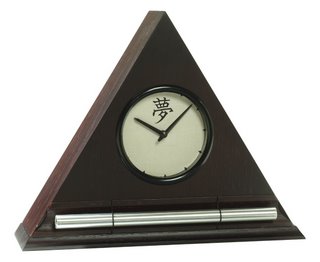 Dream Kanji Zen Alarm Clock with chime in Dark Oak Finish, a wellness tool Now & Zen
1638 Pearl Street
Boulder, CO 80302
(800) 779-6383
Posted in mindfulness practice, Well-being
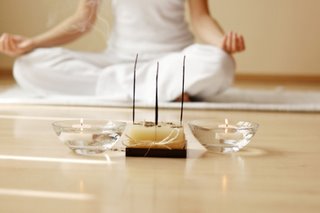 meditation can be done anywhere and anytime Meditation: Sensuousness of Breath
Time: 5 to 10 minutes.
When and Where: Anytime, anywhere.
Position: Sitting comfortably or lying down, eyes open or closed.
Intention: I bask in healing pleasure. I receive the nourishment into every cell of my body.
One of the most universal meditation practices is to take pleasure in the flow and rhythm of breath. Buddha described this as “breathing in and out sensitive to rapture.”
1. Set your Meditation Timer for 5 minutes. Breathe out with a deep sigh a few times and notice what that feels like. Let yourself make quiet whooshing sounds. If you feel a stretch or a yawn coming on, give in to it. Gently ask yourself, “What pleasure do I feel in breathing?”
2. Explore the sensations that accompany breathing — the feeling of the chest expanding and contracting, the gentle touch of the air gliding through the nose and down the throat, filling and then emptying the lungs. How luscious can you let breathing be? Perhaps you enjoy the relaxing ebb and flow of the breath, or love breathing’s whispering sounds. If you’re outside, you might savor the fragrance of grass, trees, or flowers as you inhale. You might feel simple wonder at receiving this essential gift from life.
3. Breathe with this type of awareness for 10 minutes or so, allowing your attention to be soft and undemanding, like rose petals on your skin. Thoughts and feelings about your life will come into your awareness; this is healthy and healing, so don’t try to block them out. Just keep coming back, gently, to the sensuousness of breath when you can.
adapted from Body + Soul Magazine, June 2005 by Lorin Roche and Camille Maurine
Use our unique “Zen Clock” which functions as a Yoga & Meditation Timer. It features a long-resonating acoustic chime that brings your meditation or yoga session to a gradual close, preserving the environment of stillness while also acting as an effective time signal. Our Yoga Timer & Clock can be programmed to chime at the end of the meditation or yoga session or periodically throughout the session as a kind of sonic yantra. The beauty and functionality of the Zen Clock/Timer makes it a meditation tool that can actually help you “make time” for meditation in your life. Bring yourself back to balance.
 meditation timer with chime Now & Zen – The Zen Timer & Alarm Clock Store
1638 Pearl Street
Boulder, CO 80302
(800) 779-6383
Posted in intention, Meditation Timers, Meditation Tools, Well-being, Zen Timers
 a walking practice You know that a brisk walk around the block can clear your head. But it can do even more. Walking rivals yoga, meditation, and tai chi as a powerful mindfulness practice, says Danny Dreyer, a running coach, ultramarathoner, and creator of the ChiRunning and ChiWalking programs. Dreyer has spent years teaching people how to use walking to relieve physical and mental stress by moving in a relaxed way and focusing on physical sensations.
In the following exercise, Dreyer shows how to elevate a simple walk to a meditation in motion, just by using breath and awareness to target tension and trigger the body’s relaxation response. Try this simple stress reliever before an important meeting, after a workday, or any time you need to recapture a calmer, more centered state of mind.
Find a Quiet Place
Choose to walk somewhere soothing — around a lake instead of along a busy road, for instance.
Tip: Don’t rush. Your goal here is to unwind, not to break a sweat or clock in miles. Do your best to maintain an easy gait.
Go Easy
Keep your pace comfortable (as if you don’t need to get anywhere fast) and your stride short.
Breathe Away Tension
Start with your head and observe any tension you might be feeling there. Take a deep inhale, and then with each exhale, imagine releasing tightness in your head and neck. Continue with your shoulders, arms, chest, belly, glutes, upper legs, lower legs, and feet. Spend several breaths on each area, gradually inviting every part of your body to relax. Repeat this exercise.
Take Time to Unwind
Walk for at least 15 minutes, or longer if you have time.
Tip: Focus on tension hot spots throughout your body; this will help you open up and unwind.
adapted from Body + Soul Magazine, September 2007 by Kate Hanley
 Dark Oak Zen Alarm Clock with Chime, a Meditation Timer
Now & Zen
1638 Pearl Street
Boulder, CO 80302
(800) 779-6383
Posted in Chime Alarm Clocks, intention, Meditation Timers, Meditation Tools, mindfulness practice, Now & Zen Alarm Clocks, Well-being, Zen Timepiece by Now & Zen, Zen Timers
 mindful walking Whether you’re staring at a blank page or stuck on a problem, a walk may be just the thing you need to bust through a roadblock. It can even set the stage for inspired thinking and major mental breakthroughs, says Thom Hartmann, author of “Walking Your Blues Away,” by giving you access to the full range of your thought power. “When we walk, we stimulate portions of the brain in the right and left hemispheres, giving us access to more areas of our brains than when we’re sitting still,” he explains. “A million years of evolution have equipped our bodies to operate in an optimal way when we’re walking,” he says. “It’s part of our body’s normal restorative process.” Here are his guidelines for using your daily walk to get out of a mental rut and lure your creativity out into the open.
Skip the Distractions
Wear comfortable clothing, don’t carry anything, and leave the iPod at home. This helps you stay open and balanced so you can focus.
Set a Comfortable Pace
Walk at your normal pace, which helps you sync to your body’s other rhythmic processes, such as heartbeat and breathing rate, which further creates the conditions for insight to occur.
Visualize Your Dilemma
As you’re walking, call up the issue or idea you need clarity on. It can be as richly detailed as a mental image (seeing the finished letter, signed and sealed) or as simple as a question (“What should I say to this person?”). Your mind will inevitably wander; let it. Then, gently guide your thoughts back. Hartmann explains that this interplay between conscious thinking (going over the main points in your mind) and unconscious thinking (daydreaming) brings your whole brain into play and opens you up to inspiration.
Take Your Time
According to Hartmann, the average length of time people require to have a burst in creativity is 15 minutes, or about a mile of walking.
adapted from Body + Soul Magazine, September 2007 by Katie Hanley
 Digital Zen Alarm Clocks, meditation timers and alarm clocks with chimes
Now & Zen
1638 Pearl Street
Boulder, CO 80302
(800) 779-6383
Posted in Chime Alarm Clocks, intention, mindfulness practice, Now & Zen Alarm Clocks, Well-being, Zen Timers
 entering silence, starry night in the wilderness How one woman survived three days in the wilderness—alone.
I shivered in the pitch-black night as a steady rain showered my head. I sank deeper into a state of abject loneliness with every miserable drop. My saturated sleeping bag weighed me down as I searched blindly for my flashlight, all the while berating myself for not tying up the tarp before I fell asleep beneath a formerly clear, starry night.
Feeling panicky on the first night of my solo experience in the woods, I imagined the worst—three days of rainy, damp desolation. What am I doing here? I wondered. I could be home, snuggled up with my husband in our cozy bed!
And then it hit me. I realized that this moment was exactly why I had come here—to face my demons head-on, to ride out the fear of being alone in the dark and of being eaten, possibly, by a bear. Isn’t that what a vision quest is all about? Flinging oneself into the wilderness (in this case, a California state park on Labor Day weekend, but still) to test one’s inner strength and hopefully receive some sort of life guidance, perspective, and inspiration?
For the last 10 years, I had contemplated embarking on a quest like this with awe and trepidation. An extrovert by nature, I thrive on the company of others. I can’t be alone in my own house for five minutes without feeling anxious, so how could I endure three entire days by myself? I feared I would go crazy with no one to talk to, engulfed by the deafening silence of nature.
To my surprise, I discovered that nature is extremely loud. Have you ever heard throngs of blue jays chattering overhead at the crack of dawn? I was definitely not alone—from the disturbed gopher under my sleeping bag (was I camped on his house?) to the constant parade of insects, birds, and critters, I was in a forest teaming with life and endless entertainment.
Two days later as I packed my gear, I had a hard time believing the time had passed so quickly. Suddenly the power of facing and overcoming my deepest fears overwhelmed me, and I fell to my knees sobbing. A strength I never knew existed inside me welled up as I realized I could now be alone and unafraid.
I shouldered my backpack, danced a little jig to celebrate my emancipation, and walked out of the wilderness a changed woman.
adapted from Natural Solutions Magazine, Sept. 2009 by Laura Gates
 Zen Alarm Clock, a natural chime sound alarm clock
Now & Zen
1638 Pearl Street
Boulder, CO 80302
(800) 779-6383
Posted in Bamboo Chime Clocks, Chime Alarm Clocks, Hokusai Wave, intention, Natural Awakening, Now & Zen Alarm Clocks, Progressive Awakening, sleep, Well-being
 Silk Lavender Eye Pillows Creating Eye Pillows:
Summer holidays are perfect times for craft projects. Here’s one you can do in an hour and use right away. Eye pillows are handy for traveling and for relaxing in Savasana.
Materials You’ll Need (makes one eye pillow)
For the pillow
1/2 yard of fabric that has been washed, dried, and ironed
For the filling
1/2 cup dried beans or flax seeds
1/2 cup dried rice, lentils, or buckwheat
1/2 cup dried lavender or chamomile
When selecting the filling consider the recipient’s scent preferences and any potential allergies. Mix together three or all of the above items. You’ll need 1 1/2 cups total.
 creating beautiful eye pillows Make the Pillow
Step 1 Cut the fabric
Using a ruler and pencil, mark two 4 1/2-by-10-inch rectangles on the wrong (nonprinted) side of the fabric. With a pair of scissors, cut along the marks to create the two panels needed for the pillow.
Step 2 Sew the seams
Place the two panels’ right (printed) sides together, with the raw edges aligned. Stitch a 1/2-inch seam around the raw edges, backstitching (sewing first in reverse, then forward over the same stitches) at each end. Leave one of the 4-inch sides open, so you can later add the filling. Stitch a 3/8-inch reinforcement seam around the raw edges, leaving the same 4-inch opening. This reinforcement will ensure that the mixture doesn’t leak out of the pillow after you’ve filled it.
With your scissors, cut two 1/4-inch notches in each seam allowance (the area between the stitching and the raw, cut edge of the fabric), one on either side of each of the four corners, making sure not to clip the stitching. Turn the eye pillow right side out for the next step.
Step 3 Fill the pillow
Spoon 1 1/2 cups of filling into the pillow’s open seam.
Step 4 Close the final seam
Fold each side of the remaining 4-inch seam 1/2 inch toward the inside of the pillow, and pin the opening closed. Either by hand or with a sewing machine, stitch a seam across the folded edges to close the 4-inch opening, then try out the pillow: Set your Zen Meditation Timer to 5 minutes, lie down, put it over your eyes, and treat yourself to 5 minutes of deep relaxation.
adapted from Yoga Journal, by Victoria Everman
 Zen Mediation Timers Now & Zen
1638 Pearl Street
Boulder, CO 80302
(800) 779-6383
Posted in Chime Alarm Clocks, Meditation Timers, Meditation Tools, mindfulness practice, Now & Zen Alarm Clocks, Well-being, Zen Timers
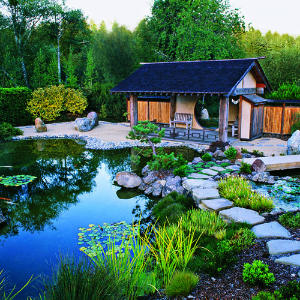 Flecked with water lilies and fringed with greenery, a heart-shaped pond exemplifies the spirit of the Osmosis Meditation Garden. A stone path leads visitors across a small bridge to the Moon Pavilion In the West, gardens are designed for outdoor living as much as for viewing. Japanese gardens, on the other hand, are more for viewing ― to communicate peace and tranquility. The new Meditation Garden at the Osmosis spa in Freestone blends the two approaches. “It’s a Japanese-style garden created for California,” says owner Michael Stusser. The design, by Robert Ketchell, founder of the British Japanese Garden Society, is Japanese, but the use of California native plants and the lovely coastal-hills setting tie it directly to the region.
What makes it so serene? A mirror-smooth pond reflects the day’s changing light and passing clouds. Plantings are simple yet sculptural: a single conifer beside a shapely boulder in one area, a Japanese maple and several conifers in another. Gravel raked in swirls around boulders evokes the feeling of water.
Like Japanese gardens, the Meditation Garden is meant to be viewed through a moon window in the pavilion near the pond. But like a California garden, it invites you in to feel the tranquility.
INFO: Osmosis: The Enzyme Bath Spa (209 Bohemian Hwy., Freestone; 707/823-8231) celebrates its 20th anniversary on Sep 9 with a concert and sushi buffet ($65); tickets limited.
Osmosis is having a 25 year anniversary celebration on September 12th with food music and complementary cedar enzyme foot baths. The cost is $25.
Garden tours are planned for every Sunday in October between 11am and 3:00pm
adapted from Sunset Magazine, by Lauren Bonar Swezey
Posted in Bamboo Chime Clocks, Hot Springs, Now & Zen Alarm Clocks, teahouse, Well-being
 Reiki Treatment Reiki, a Japanese healing treatment, quiets the body and spirit by tapping into a “life force.”
“Universal life energy” is what Reiki (pronounced RAY-kee) means in Japanese. Reiki practitioners use this energy-the subtle vibrational force that surrounds and permeates every living thing- to enhance and balance the body, says Susan Mitchell, a Reiki master and owner of Reiki Healing Arts in Coeur d’Alene, Idaho. “The practitioner acts as a conduit,” explains Beth White, a Reiki master in New York City. “During a session, the energy flows through the practitioner’s hands and you absorb it on a physical, mental, emotional, and spiritual level.” The result? A feeling of meditative peace.
Evidence
Reiki originated in Japan in the 1920s and was brought to the United States in the 1930s by Hawayo Takata, a Japanese-American. Although the studies of Reiki thus far have been small (five larger ones sponsored by the National Institutes of Health are under way), they indicate-as does strong anecdotal evidence-that the method is effective at reducing pain, anxiety, and stress, and increasing a sense of wellbeing. A study published last year in Integrative Cancer Therapies compared the effects of Reiki treatments with the effects of rest on fatigue, pain, anxiety, and overall quality of life in 16 cancer patients. Researchers found that the individuals who received Reiki experienced increases in quality of life and decreases in fatigue, changes that were not seen with rest alone.
Pamela Miles, a Reiki master in New York City and author of Reiki: A Comprehensive Guide (Tarcher, 2006), says the physiological changes seen following a Reiki session include a healthy decrease in heart rate and blood pressure and an increase in salivary immune hormones. “Reiki can help make your body’s self healing mechanism more effective,” she says. “Universal life energy” is what Reiki (pronounced RAY-kee) means in Japanese. Reiki practitioners use this energy-the subtle vibrational force that surrounds and permeates every living thing- to enhance and balance the body, says Susan Mitchell, a Reiki master and owner of Reiki Healing Arts in Coeur d’Alene, Idaho. “The practitioner acts as a conduit,” explains Beth White, a Reiki master in New York City. “During a session, the energy flows through the practitioner’s hands and you absorb it on a physical, mental, emotional, and spiritual level.” The result? A feeling of meditative peace.
 Reiki Evidence
Reiki originated in Japan in the 1920s and was brought to the United States in the 1930s by Hawayo Takata, a Japanese-American. Although the studies of Reiki thus far have been small (five larger ones sponsored by the National Institutes of Health are under way), they indicate-as does strong anecdotal evidence-that the method is effective at reducing pain, anxiety, and stress, and increasing a sense of wellbeing. A study published last year in Integrative Cancer Therapies compared the effects of Reiki treatments with the effects of rest on fatigue, pain, anxiety, and overall quality of life in 16 cancer patients. Researchers found that the individuals who received Reiki experienced increases in quality of life and decreases in fatigue, changes that were not seen with rest alone.
Pamela Miles, a Reiki master in New York City and author of Reiki: A Comprehensive Guide (Tarcher, 2006), says the physiological changes seen following a Reiki session include a healthy decrease in heart rate and blood pressure and an increase in salivary immune hormones. “Reiki can help make your body’s self healing mechanism more effective,” she says.
A typical session
During a Reiki treatment, you lie down on a massage table while the practitioner places her hands in various positions on your head, throat, and front and back torso. (Clients are fully clothed, unless Reiki is used in combination with another treatment like a massage.) You may enter a state of deep relaxation. Many people report seeing colors and moving shapes, sensing pulsations, and feeling hot or cold. In many cases, though, the result is improved energy and a sense of wellbeing. “I go into what feels like a deep sleep,” says Spiegler, “and an hour later I ‘wake up,’ feeling totally rejuvenated.”
adapted from Natural Health Magazine, August 2008 by Susan Hayes
 Bamboo Digital Chime Clock, a Reiki Timer and Clock Now & Zen
1638 Pearl Street
Boulder, CO 80302
(800) 779-6383
Posted in Bamboo Chime Clocks, Chime Alarm Clocks, intention, Japanese Inspired Zen Clocks, mindfulness practice, Now & Zen Alarm Clocks, Well-being
Kyoto meets Giverny in this artful garden, a sublime space for contemplation.
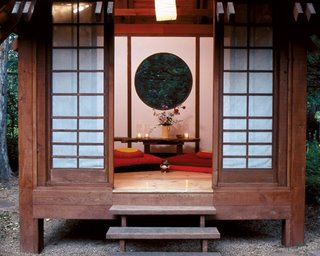 teahouse, photo by Povy Kendal Atchison Japanese shoji screens traditionally are made from translucent rice paper, but the owners chose a durable, light-penetrating fabric that will prevail in harsh weather. It allows filtered light without sacrificing privacy. The floor is salvaged pine planks from a park ranger’s mountain cabin, and a round window brings in the garden even when the doors are closed.
Ten years ago, a Boulder, Colorado, couple bought a house on a patch of grass with some overgrown shrubs, sliced by an irrigation ditch. Where many people might have seen desolation, these intrepid gardeners saw the opportunity to create a private world of solitude and renewal. In the process, they discovered that designing and planting is as soothing as enjoying the completed garden.
The contemplative garden they’ve created gently nods to Asian style while embracing European impressionism. It borrows from 19th-century impressionist painter Claude Monet, as well as from the Japanese love of plant textures, weeping trees and artfully placed rocks. It includes water, rocks, expanses of greenery and winding paths, but not the formal Japanese plantings that require so much upkeep.
Monet’s famous garden in Giverny, France, includes a Japanese bridge over a water lily pond. In this Colorado garden, a pale-aqua bridge arches over an irrigation ditch that’s been funneling water to farmers for 100 years. Just as the lily pad pond became the Monet garden’s major draw, the ditch has been transformed—lined with sandstone rocks alongside a bed of river rocks. Gold, yellow and orange daylilies drape the bank, blooming in midsummer when the Siberian and Japanese irises offer only seed pods. Ornamental grasses bend and sway to the breeze stirred up by the water’s flow. The ditch is an enticement; visitors brace against the railing and peer into the water, watching blossoms float downstream.
Every corner of this garden was designed with careful thought, not lavish funds. A decade of hard work and trial-and-error provided an education.
Piecing together elegance
Every corner of this garden was designed with careful thought, not lavish funds. A decade of hard work and trial-and-error provided an education. In hindsight, the homeowners believe their decision to tackle their garden in small pieces rather than taking on the entire half-acre saved them time, money and frustration.
“We didn’t have a grand master plan,” one of the homeowners admits. Instead, he started by clearing dead and dying trees. Then he parceled the property into smaller gardens: a ditch lined with water-loving plants and flagstones circles the edges of the gardens and is sprinkled with elfin thyme and other herbs for groundcover.
To imitate nature’s undulating, uneven landscape, he built mounds, or berms, from garden soil, adding interest to the flat piece of land. Berms also provide quick drainage for plants that might never take hold without humus and gravel. Sun-loving plants such as foxtail lilies and peonies are located on the sunny mounds. Shade-loving hostas line the flagstone walkways under giant locust trees.
“It all came together like a jigsaw puzzle,” the gardener says, with groundcovers of thyme and vinca, creeping veronica, wild strawberries and sweet woodruff. Groundcovers that can become invasive thugs, such as the sweet woodruff, were banished to the riverbank under the house, where it can duke it out with ornamental strawberries for space and light.
What’s in this garden?
• Crabapple trees (Malus spp), highly adaptable to most weather and soil conditions, have exquisite spring blooms. The weeping varieties include Red Jade, Coral Cascade, White Cascade and Louisa. Best to order from your local garden center.
• Species (or wild) tulips (Tulipa spp) have brilliant hues and hardiness. Long before more formal tulips became the backbone of Dutch gardens, miniature species tulips blanketed hillsides in Turkey. Most only can be grown in climates with winter temperatures. Order from trustworthy companies (see “Resources,” below) that propagate their own bulbs and do not harvest from the wild.
• Foxtail lilies (Eremurus spp) have attention-grabbing feathery spikes and day-glow colors. They’re easy to grow, but they do require good drainage to avoid root rot.
• Thyme (Thymus spp) may be slow to start, but once established, it tolerates some foot traffic. Best as filler between stepping stones, aromatic thymes will creep around rocks and steps, choking out weeds.
• Daylilies (Hemerocallis spp) have sweeping, grasslike foliage and arching blooms. Each blossom lasts only one day, but the plant blooms nonstop throughout summer. They require little care aside from division every few years, and only a moderate amount of water.
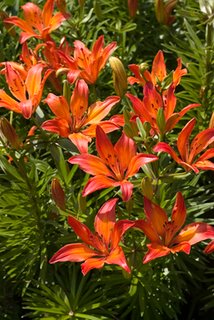 daylilies • Irises (Iris spp) are easy to grow if you choose the right cultivars for your garden. Siberian and Japanese irises grow best in moist, slightly acid soil, perhaps on the banks of a pond or stream. For alkaline soil and aridity, choose bearded irises. And if you love variegated leaves of white and green, look into Iris pallida.
• Hostas (Funkia spp), with wide, variegated leaves, add to foliage interest rather than floral displays. Lords of the shade garden, hostas can be found in a variety of sizes, some with blue-tinged or gold coloration and heart-shape leaves. All need some moisture and dappled shade.
Four seasons of splendor
In this garden, bold plants such as peonies and foxtail lilies are the prima donnas—showy and extravagant with heavy blooms. Other beauties are far smaller and require a closer look. Brilliant red and yellow species tulips—more natural looking than their formal, hybrid cousins—pop up among drifts of thyme. Delphiniums and their smaller brethren, larkspur, join foxgloves for height and extravagant color. Oriental poppies and California poppies display papery petals, popping up in mounds and drifts.
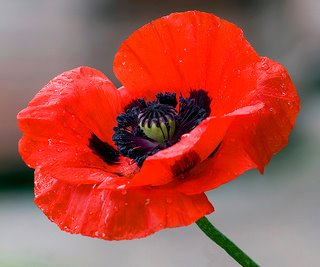 oriental poppy In early spring, the bright blues and purples of the groundcovers cluster throughout the garden, complementing the species tulips’ tiny blooms. By late spring, foxgloves and Siberian and Japanese irises dominate. Summer is golden, as daylilies offer orange, yellow and cream colors.
The garden may be at its best in winter, the gardeners claim. Japanese lanterns guide visitors down the flagstone footpath, and snow sets a black-and-white scene. Bare, weeping crabapple branches bend gracefully like sculpture. “Some of the most beautiful times in the garden are in the snow,” the homeowner says. “You see all the shapes that don’t go away: the mounds, rocks, ornaments, trellises.”
Reflecting in the teahouse
Autumn and winter usher in the garden’s quiet moments, when trowels are put away. A tiny teahouse, built of salvaged cedar siding left over after the house was built, holds sway. Once inside, a cup of hot tea banishes the cold. Sliding shoji screen doors open to the sparkling light on snow or close to keep out a brisk wind. The nine-by-nine-foot teahouse anchors this garden, a reminder that its primary purpose is to promote meditation and reflection rather than busyness. A Zen Timepiece adornes the interior so that one can timer their meditation practice. The naked branches of an old cottonwood tree loom over the teahouse while smaller pines and dwarf evergreens screen the street and neighborhood. “The teahouse gave us a focus for the garden,” the homeowner says, “and cut down the amount of lawn.”
In winter’s stillness, when birds are silent, only the bamboo wind chimes clink softly. The teahouse’s back wall features a round window that provides the most private views and connects the garden to the teahouse. “I wanted a big round window,” the owner says, “to bring the outside in.”
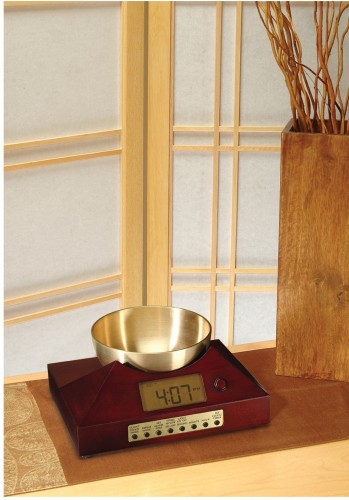 Zen Timepiece with brass singing bowl, a meditation timer. adapted from Natural Home Magazine, March/April 2008 by Niki Hayden
Now & Zen
1638 Pearl Street
Boulder, CO 80302
(800) 779-6383
Posted in Bamboo Chime Clocks, Chime Alarm Clocks, Japanese Inspired Zen Clocks, Now & Zen Alarm Clocks, teahouse, Well-being, Zen Timepiece by Now & Zen, Zen Timers
« Previous Page — « Previous Entries
Next Entries » — Next Page »
|
|
|
|